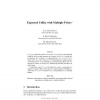Free Online Productivity Tools
i2Speak
i2Symbol
i2OCR
iTex2Img
iWeb2Print
iWeb2Shot
i2Type
iPdf2Split
iPdf2Merge
i2Bopomofo
i2Arabic
i2Style
i2Image
i2PDF
iLatex2Rtf
Sci2ools
82
Voted
ISIPTA
2003
IEEE
2003
IEEE
Expected Utility with Multiple Priors
Let be a preference relation on a convex set F. Necessary and sufficient conditions are given that guarantee the existence of a set {ul} of affine utility functions on F such that is represented by U (f) = ul (f) if f ∈ Fl; where each Fl is a convex subset of F. The interpretation is simple: facing a “non-homogeneous” set F of alternatives, a decision maker splits it into “homogeneous” subsets Fl, and acts as a standard expected utility maximizer on each of them. In particular, when F is a set of simple acts, each ul corresponds to a subjective expected utility with respect to a finitely additive probability Pl; while when F is a set of continuous acts, each probability Pl is countably additive. Keywords preference representation, subjective probability, nonexpected utility, integral representation, multiple priors, countable additivity
Related Content
| Added | 04 Jul 2010 |
| Updated | 04 Jul 2010 |
| Type | Conference |
| Year | 2003 |
| Where | ISIPTA |
| Authors | Erio Castagnoli, Fabio Maccheroni, Massimo Marinacci |
Comments (0)

